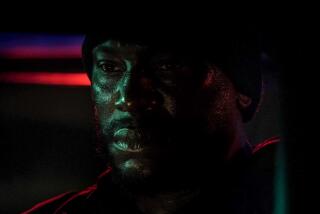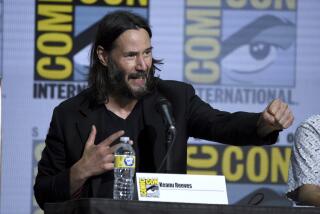‘Inherent Vice’ by Thomas Pynchon
“Inherent Vice” is Thomas Pynchon doing Raymond Chandler through a Jim Rockford looking glass, starring Cheech Marin (or maybe Tommy Chong). What could easily be mistaken as a paean to 1960s Southern California is also a sly herald of that era’s end. This, of course, is exactly the kind of layered meaning that readers expect of Pynchon.
His fans tend to be drawn to either his massive, bafflingly complex efforts -- the iconic, National Book Award-winning “Gravity’s Rainbow,” “Mason & Dixon” and “Against the Day” -- or to the more constrained, plot-driven narratives of “Vineland” or “The Crying of Lot 49.” It is the big books, with their parades of gloriously obtuse set pieces, full of slapstick and conspiracy and minutely researched ephemera, that established Pynchon as a writer worthy of intense inquiry. Yet having a plot doesn’t make his work any less brilliant, any less Pynchonian. “Inherent Vice” is a perfect case in point. It has a plot. It has a main character. This clear structure will, no doubt, disappoint the big-book boosters, the obsessives who began contributing to the online wiki annotation of “Against the Day” before finishing its 1,085 pages. But maybe we should all take a hit off a fat spliff and enjoy the dirty, brainy achievement of Pynchon’s “Vice.”
At the center of “Inherent Vice” is Doc Sportello, a low-key private investigator living in a dingy bachelor pad in Gordita, a beach community with Venice’s grit and Malibu’s surfers and hills. He has little affection for nonhippie flatlanders and a love of good weed. But Doc is more law and order than his indica might indicate: His occasional girlfriend is an assistant district attorney, and he’s got an enduring across-the-divide, almost-friendship with Bigfoot Bjornsen, an LAPD detective who does Cal Worthington-like TV spots on the side. It’s these straight-world connections that bring Doc’s ex-girlfriend Shasta Fay Hepworth to his doorstep asking for help.
In a detective fiction setup worthy of Chandler, Shasta -- a minor actress and mistress of real estate mogul Mickey Wolfmann -- tells Doc that her lover’s wife, who has a lover of her own, is trying to ship Mickey off to an insane asylum so she can take control of his fortune. Doc takes the case, but before his investigation can get off the ground, he’s accused of murder, picked up and released by the cops and the FBI and discovers that both Shasta and Mickey have gone missing. No client, no money, but a mystery to solve.
Weirdness and obsession
Doc does true detective work -- dressing up in disguises, following leads -- yet he’s stoned most of the time and easily distracted. His world is full of Pynchonian weirdness: an ex-junkie sax player who has faked his own death and is living, unrecognized, with his band in Topanga Canyon; a surfer who ventures out too far to catch impossible waves; a lawyer fixated on the minutiae of “Gilligan’s Island” and other trash TV; and Mickey’s collection of pornographic ties, decorated with images of his lovers -- although Shasta is conspicuously missing.
Nearly every character has an obsession or addiction. Doc’s almost constantly altered state allows the unreal to shimmer against reality like light on an ocean. Sentences appear and Doc wonders if he’s said them aloud; he never finds out, and we can’t be sure. A clue discovered on an acid trip is as valuable as anything learned while straight. And his cannabis-induced paranoia is only a quarter turn from his detective work -- especially when he comes across references to the mysterious Golden Fang. Doc knows the Golden Fang is a boat with a mysterious, historic past. But it also seems to be a consortium of horny Silver Lake dentists, not to mention an Asian gang connected to drugs and money, Vietnam and China.
In classic Pynchon fashion, random incidents add up to conspiracy -- maybe. Behind powerful figures loom shadowy, more powerful figures, and complex layers of knowledge lead to confusion as much as clarity. There is also a lot of sex (if little romance), many pop-culture allusions (one scene references at least two classic noir films), characters who cross over from Pynchon’s other work (“Vineland,” predominantly) and silly names galore.
It’s easy to forget, among all his games and puzzles, that Pynchon can write razor-sharp beauty with the best of them. A page-long description of the Santa Anas demands a place next to classic passages by Chandler and Joan Didion.
In Pynchon’s big books, these devastating descriptions, particularly of place, are often swept away in the tide of prose and characters. Here, in a novel that focuses on Los Angeles so sharply that Tommy’s is pinpointed by its cross streets, they shine.
L.A. on his mind
Pynchon, now 72, apparently lived in Southern California in the 1960s, and the attention to L.A.’s geography implies that the region has remained on his mind. Maybe he’s got a clear sense of recall -- or maybe he comes back to visit or has devoted time to exploring Google Maps’ street views. Either way, his details of the city are precise.
The Internet does make an appearance in “Inherent Vice,” with a reference to the pre-Web ARPAnet and a prescient sense of future connection. “Someday,” a real estate agent says, “there will be computers for all this, all you’ll have to do’s type in what you’re looking for . . . and it’ll be right back at you with more information than you’d ever want to know, any lot in the L.A. Basin all the way back to the Spanish land grants -- water rights, encumbrances, mortgage histories, whatever you want.” The idea reads as both hope and lament.
And yet, if “Inherent Vice” exhibits nostalgia, it is not for the Los Angeles of yesteryear but for the days when genuine mystery was possible, when Doc’s acid trip could be as relevant as Det. Bjornsen’s world, when complex layers could both contradict and coexist. It’s a love letter to a time when obsessives couldn’t get all the answers from computers, when we might embrace the unknowable.
Still, after getting pretty far out, “Inherent Vice” eventually circles back and ties up all its loose ends. It has a climactic moment, a cushiony denouement -- by gum, closure. If this stands in counterpoint to Pynchon’s most acclaimed work, perhaps we should pay heed to the novel’s title: “Inherent Vice” refers to a hidden defect that undermines a property’s worth, a marine-legal term for a Shakespearean flaw. It could refer to Los Angeles; it could refer to the 1960s. Or it could refer to the author’s work itself: With Pynchon’s brilliance comes readability.
Kellogg is the lead blogger for Jacket Copy, The Times’ book blog.
More to Read
The biggest entertainment stories
Get our big stories about Hollywood, film, television, music, arts, culture and more right in your inbox as soon as they publish.
You may occasionally receive promotional content from the Los Angeles Times.










